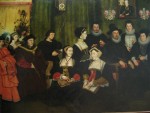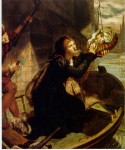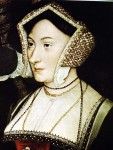- Sir Thomas More, his father, his household and his descendants.
- Margaret Roper rescues her father’s severed head from being thrown away.
- Margaret Roper, née More. Eldest daughter of Sir Thomas More. Detail from a family picture.
by Koren Whipp
Margaret More Roper (1505-44), the eldest daughter of Thomas More, lord chancellor of England, and Joanna Colt, often called ‘Jane’ by modern writers, was born at home in late summer or early autumn of 1505 in Bucklersbury, London, five hundred yards north of the Thames.[1] The More children, Margaret, Elizabeth More Dancy, Cecily More Heron, John More, and adopted daughter, Margaret Gigs Clement , were given a humanist education, learning Latin, Greek, Logic, Philosophy, Theology, Mathematics, and Astronomy.[2] Becoming too busy in the King’s service to continue his children’s education himself, Thomas More hired William Gonnell as full-time tutor. He was an experienced teacher from Landbeach, near Cambridge, and a close friend of Erasmus, who himself had contact with all the More sisters and considered More’s daughters to have ”outstanding talents”.[3] Gonnell arrived in the More household in May 1518, when Margaret was twelve years old.
A year after Gonnell became the family’s tutor, a letter to More from either Gonnell or Margaret suggested that she had progressed so rapidly that she might eventually publish a book. Although her father advocated education for his daughters, certain boundaries must be maintained. More replied sternly that Margaret’s “lofty and exalted character of mind [should not be] debased [by pandering to] what is vain and low.”[4] Moral virtue was prized above literary fame, particularly in women. “To lay herself out for reknown [in this way] is the sign of someone who is not only arrogant, but ridiculous and miserable.”[5] More also appeared to worry that women who publicly exhibited their intelligence would harm the public’s acceptance of educating girls: “since erudition in women is a new thing and a reproach to the sloth of men,” women should maintain ”appropriate modesty.”[6] If a woman strove to become a published author in her lifetime, it could adversely affect the general advancement of women’s education.[7] Because of this attitude, More was required to take care in highlighting his daughter’s achievements. When a friend expressed disbelief in female authorship when shown an example of Margaret’s work, More explained to his daughter the constant difficulty she would encounter:
Something I once said to you in a joke came back to my mind, and I realized how true it was. It was to the effect that you were to be pitied, because the incredulity of men would rob you of the praise you so richly deserved for your laborious vigils, as they would never believe, when they read what you had written, that you had not often availed yourself of another’s help: whereas of all the writers you least deserved to be thus suspected.[8]
If women privately exhibited their scholarship, they were doubted and were forced to prove themselves, however, if they publicly displayed their intellect, they were dishonored. Margaret listened to her father’s advice while he lived, but ultimately published in her own lifetime.
Margaret was a prolific writer and creative translator, but only a portion of her work has survived. Her Latin and Greek verses, her Latin speeches, her imitation of Quintilian, and her treatise, The Four Laste Thynges, which her father considered equal to his own account, have all been lost.[9] The only surviving works are a scattering of letters and the translation of Erasmus’s Precatio Dominica as A devout treatise upon the Paternoster published in 1524.
Margaret married William Roper, eldest son of Thomas More’s former teacher, in 1521 at age sixteen. They had five children together: Elizabeth (1523–60), Margaret (1526–88), Thomas (1533–98), Mary (d. 1572), and Anthony (1544-1597).
An opponent of the Protestant Reformation, Thomas More was tried for treason and beheaded in 1535. Thomas Stapleton, early biographer of Thomas More, conveys the story of Margaret obtaining her father’s head after his execution. Writing in 1588, Stapleton records the incident given to him by an eyewitness of the event:
[The head] by order of the king, was placed upon a stake on London Bridge, where it remained for nearly a month, until it had to be taken down to make room for other heads…The head would have been thrown into the river had not Margaret Roper, who had been watching carefully and waiting for the opportunity, bribed the executioner, whose office it was to remove the heads, and obtained possession of the sacred relic.[10]
After Margaret retrieved her father’s head, she was summoned before the King’s Council and charged with crimes against the state. She was charged with keeping her father’s head as a sacred relic, as well as retaining possession of his books and writings. Although the validity of the story of the bribe is uncertain, Margaret was detained by Thomas Cromwell overnight, probably in a privy councilor’s house, from which she was released the next day, most likely in the summer of 1537.[11]
Margaret More Roper died in 1544 at age thirty-nine. Earlier scholarship suggested that her father’s head was interred with her at her request.[12] Modern scholarship reveals that Thomas More’s head was found with her when Margaret’s body was disinterred and removed from the More family vault to be buried with her husband in the Roper Chapel in St Dunstan’s Church, Canterbury. Thomas Moore’s skull was then set into the wall of the vault in St. Dunstan’s Church and kept as a holy relic.[13]
[1] Koren Whipp, “Cecilia Heron,” Mary Hays, Female Biography; or, Memoirs of Illustrious and Celebrated Women, of All Ages and Countries (1803). Chawton House Library Series: Women’s Memoirs, ed. Gina Luria Walker, Memoirs of Women Writers Part II (Pickering & Chatto: London, 2013), vol. 8, 436, editorial notes, 606-7, on 606.
[2] E. E. Reynolds, Margaret Roper: Eldest Daughter of St. Thomas More ( New York: P. J. Kenedy & Sons. 1960), 27.
[3] Lorna Barrow, “Margaret Roper,” Mary Hays, Female Biography; or, Memoirs of Illustrious and Celebrated Women, of All Ages and Countries (1803). Chawton House Library Series: Women’s Memoirs, ed. Gina Luria Walker, Memoirs of Women Writers Part II (Pickering & Chatto: London, 2013), vol. 10, 92-104, editorial notes, 579-82, on 581; and P. Iver Kaufman, ‘Absolute Margaret: Margaret More Roper and “Well Learned” Men’, The Sixteenth Century Journal, 2:3 (1989), 443-56, on 453.
[4] John Guy, A Daughter’s Love: Thomas More and His Dearest Meg (Boston: Houghton Mifflin Harcourt. 2008), 64.
[5] Guy, A Daughter’s Love, 64-5.
[6] Guy, A Daughter’s Love, 64.
[7] Guy, A Daughter’s Love, 64.
[8] Guy, A Daughter’s Love, 70.
[9] Patricia Demers, “Margaret Roper & Erasmus: The Relationship of Translator and Source,” WWR, Spring 2005: Volume 1, Issue 1, Accessed: July 14, 2014, http://www.crcstudio.org/wwr_magazine/online/spring_05/sp05_art1_roper.php.
[10] Reynolds, Margaret Roper, 110.
[11] Lorna Barrow, “Margaret Roper,” vol. 10, 92-104, editorial notes, 579-82, on 581.
[12] Mary Hays, “Margaret Roper,” Female Biography; or Memoirs of Illustrious and Celebrated Women of all Ages and Countries (6 volumes) (London: R. Phillips, 1803), vol. 6, 90-102, on 101.
[13] Lorna Barrow, “Margaret Roper,” vol. 10, 92-104, editorial notes, 579-82, on 582.
Bibliography
Barrow, Lorna. “Margaret Roper.” Mary Hays, Female Biography; or, Memoirs of Illustrious and Celebrated Women, of All Ages and Countries (1803). Chawton House Library Series: Women’s Memoirs, ed. Gina Luria Walker, Memoirs of Women Writers Part II. Pickering & Chatto: London, 2013, vol. 10, 92-104, editorial notes, 579-82.
Demers, Patricia. “Margaret Roper and Erasmus: The Relationship of Translator and Source.” WWR The Official Magazine of Women Writing and Reading. Spring 2005: Volume 1, Issue 1. <http://www.crcstudio.org/wwr_magazine/online/spring_05/sp05_art1_roper.php>
Goodrich, Jaime. “Thomas More and Margaret More Roper: A Case for Rethinking Women’s Participation in the Early Modern Public Sphere.” Sixteenth Century Journal. XXXIX/4 (2008).
Guy, John. A Daughter’s Love: Thomas More and His Dearest Meg. Boston: Houghton Mifflin Harcourt. 2008.
Hays, Mary. “Margaret Roper.” Female Biography; or Memoirs of Illustrious and Celebrated Women of all Ages and Countries (6 volumes). London: R. Phillips, 1803, vol. 6, 90-102.
Kaufman, P. Iver. ‘Absolute Margaret: Margaret More Roper and “Well Learned” Men’, The Sixteenth Century Journal, 2:3, 1989, 443-56.
Manning, Anne. The Household of Sir Thomas More with Roper’s Life of More. London: J. M. Dent & Sons Ltd. 1932.
“Miss Manning’s Picture of More’s Home.” The New York Times. 1895. <http://query.nytimes.com/mem/archivefree/pdf?res=F40B10FC355911738DDDA10894DA415B8585F0D3>
Reynolds, E. E. Margaret Roper: Eldest Daughter of St. Thomas More. New York: P. J. Kenedy & Sons.
Stapleton, Thomas. Quoted in Reynolds, E. E. Margaret Roper: Eldest Daughter of St. Thomas More. New York: P. J. Kenedy & Sons.
Whipp, Koren. “Cecilia Heron.” Mary Hays, Female Biography; or, Memoirs of Illustrious and Celebrated Women, of All Ages and Countries (1803). Chawton House Library Series: Women’s Memoirs, ed. Gina Luria Walker, Memoirs of Women Writers Part II. Pickering & Chatto: London, 2013, vol. 8, 436, editorial notes, 606-7.
Resources:
Brooklyn Museum
Elizabeth A. Sackler Center for Feminist Art: The Dinner Party: Heritage Floor: Margaret Roper
https://www.brooklynmuseum.org/eascfa/dinner_party/heritage_floor/margaret_roper.php
Page citation:
Koren Whipp. “Margaret More Roper.” Project Continua (February 22, 2015): Ver. 1, [date accessed], http://www.projectcontinua.org/margaret-more-roper/
Tags: End of Renaissance, Europe, Reformation, Translators, Writers



